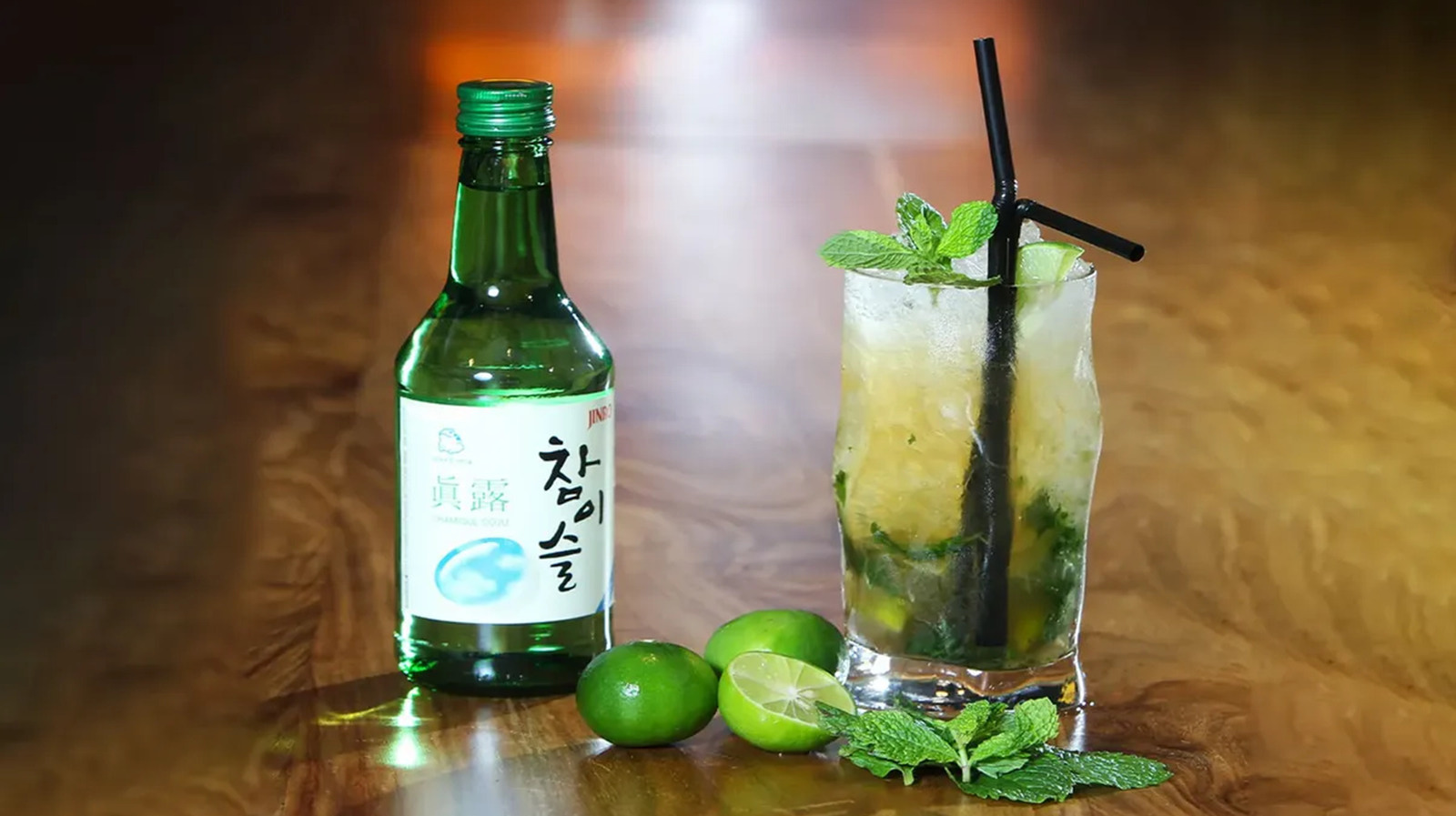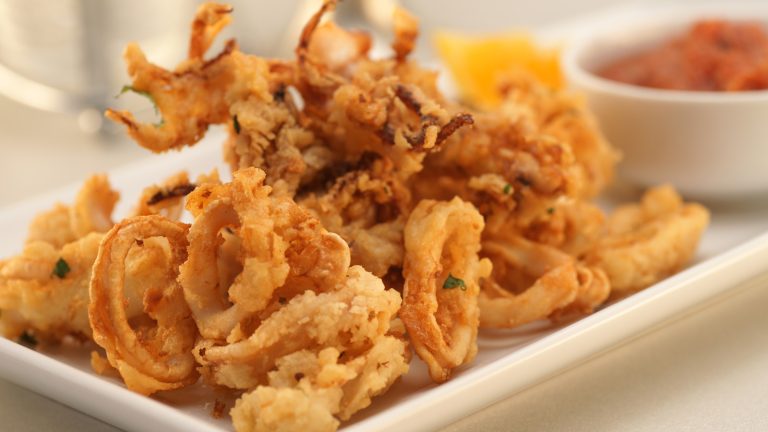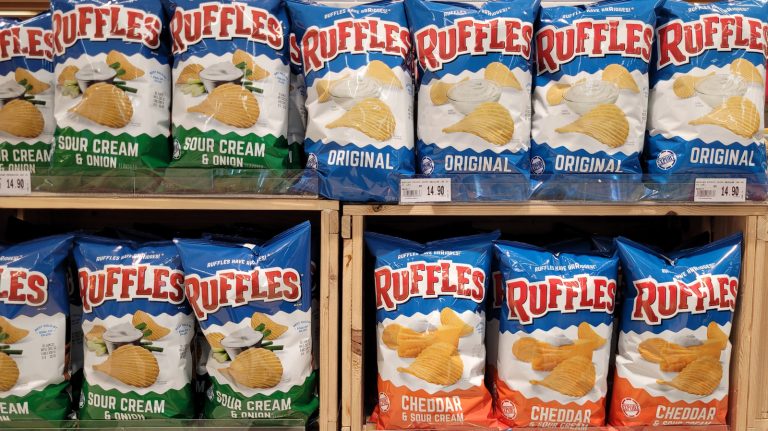If you have a Korean barbecue restaurant or two on your regular rotation, you’ve no doubt enjoyed soju, Korea’s national drink. A distilled beverage made from rice or barley, it’s mildly sweet, with a lower alcohol content than Western distilled spirits. Its flavor and drinkability make it a perfect match for hearty Korean dishes such as grilled pork belly and noodles, and in Korea, it’s not just a drink but an important cultural touchstone. Soju is so revered that according to Korean tradition, a complex system of rules governs how soju is served and who gets served when. For instance, picking up the bottle and serving yourself is considered very bad form.
Here in North America, however, drinkers are free to enjoy soju any way they want. While purists say it’s best served chilled in a traditional small glass (preferably poured by someone younger or more junior than you), you are free to pour your own if you wish. And you don’t have to drink it straight — in Korea, it’s also used to make mixed drinks, and mixologists around the world have devised numerous creative ways to incorporate it into cocktails. To share some expert tips on how to incorporate soju into cocktails is Bryan Quoc Le, food scientist, soju aficionado, and founder of Mendocino Food Consulting.
Mix it with iced green tea for a cooling refresher
Sometimes, the best cocktails are the simplest. “A Korean iced green tea with soju is always a classic,” Bryan Quoc Le said. Its simplicity is certainly part of the reason for its staying power: It’s nothing more than an ounce each of cold green tea and soju over ice in a rocks glass. If you want to get fancy, you can garnish your drink with lime wedges to accentuate the green color and add an extra bit of sparkle.
This easy drink also lends itself to fun variations. To make it even fancier, you can add sparkling wine and a touch of lemon and serve it in a champagne flute with a mint garnish. If you’re not a fan of green tea, soju pairs well with other tea varieties as well. For instance, its mild, fruity flavor makes it a good match with peach tea. And for a clever twist, make a tea-soju infusion by infusing the contents of a teabag (any tea you like) in soju for 6 to 8 hours, straining out the tea leaves before pouring the infusion into a glass over ice, and topping it with soda or tonic water.
Try a Seoul mule with ginger ale and soju
Among the easiest cocktails to make and drink are mules – basically simple mixtures of ginger ale or ginger beer, a squeeze of lemon or lime, and the liquor of your choice, often served in a copper mug. The earliest versions emerged in the 19th century. But the best-known version, the Moscow Mule, wasn’t invented until the 1940s, when a Los Angeles barkeeper and two friends found themselves with three problems: a surplus of vodka (then relatively unknown to American drinkers), an overstock of ginger beer, and a bunch of unsold copper mugs from a family factory. They put their heads (and all these unwanted items) together, gave the concoction a catchy name (the term mule was supposed to refer to the spicy kick of the ginger beer as well as the alcoholic kick of the vodka), and a classic was born.
Today, bartenders make mules with everything from rum to tequila. And by switching out the vodka for soju, you can make a Seoul mule. While more flavorful than vodka, most soju has a gentle, understated flavor as well as half the alcohol content of vodka. So, if you want it to have a noticeable presence in your mule, you may have to use a higher proportion of soju in your drink that you would with other liquors. However, you make it, you’ll end up with a smoother, delightfully different take on a classic.
Soju is a great partner for fruity flavors
Soju’s mild, natural sweetness makes it a good match for ingredients with similar flavor profiles. “Soju tends to complement fruity, citrus, and sweet flavors in cocktails,” Bryan Quoc Le said. Thus, it’s no surprise that soju frequently appears in fruit-forward cocktails. And these can be as varied in flavor and presentation as the world of fruit itself, ranging from super-sweet and playful to subtle and elegant.
A fun and easy cocktail for a crowd, for example, is a watermelon soju punch, which is simply equal parts of de-seeded watermelon flesh and soju blended together and served over ice in a hollowed-out watermelon shell. You can serve this is inside a big watermelon shell with multiple straws for a group to share or find mini melons for cute, individually sized servings. For an elegant, citrusy drink with herbal notes, make a soju smash with soju flavored with lemon juice, crushed mint, and fresh cucumber topped with sparkling water.
It also mixes well with tangy dairy, such as yogurt
We don’t typically think of dairy as a cocktail component, with the exception of the occasional beer float or creamy seasonal tipples such as spiked eggnog or Tom and Jerry. But milky cocktails don’t have to be super-rich or over-the-top sweet — in Korea, soju often appears in yogurt-based cocktails whose flavors are tart and refreshing, rather than rich and sugary. As Bryan Quoc Le explained, soju itself has a mildly tart flavor, and this complements the natural tang of yogurt.
In Korea, a favorite easy cocktail features soju mixed with a Korean or Japanese-style prepared yogurt drink, such as Yakult, then topped with lemon-lime soda. These yogurt drinks are thinner than Western-style yogurt (rather like kefir), and the soda adds sparkle and lightness you probably wouldn’t expect in a creamy cocktail. Besides being super-easy, this drink lends itself to endless riffs. Yakult comes in a range of fruity flavors, so you can change the flavor of your drink by changing your choice of yogurt. Alternatively, you can add extra flavor by using a fruit-flavored soju. And if you’re in the mood for extra tartness, switch out the soda for grapefruit juice.
When subbing soju for other liquors, you may have to tweak the recipe
The rising popularity of soju cocktails may have inspired you to try your hand at your own soju-based creations. And a common strategy for creative mixologists is to create a fresh twist on a well-loved traditional cocktail by swapping out the liquor — the vodka martini, for example, is a well-known riff on the classic gin-based version. Look for soju recipes online, and you’ll find plenty of inspiration for soju-based cosmopolitans, margaritas, and more.
Don’t expect these, however, to taste like the originals, since soju has a very different character from other common distilled liquors. “It can sometimes be tough to substitute soju in cocktails with other liquors, as most liquors tend to have higher alcohol content and are more bitter than soju,” Bryan Quoc Le said. “Soju itself is smoother and sweeter than hard liquors.” This means, he explained, that you will likely have to tweak the ingredients or their proportions in your drink to get a balanced blend — for instance, you might need a bigger amount of soju to get a similar mouthfeel.
Try Chamisul soju in a twist on the tequila sunrise
If you’ve discovered soju cocktails and want to try a deeper dive, a useful thing to know is that soju is more varied than many people think. Like beer, it not only comes in easy-drinking mass market varieties, but in distinctive historic, regional styles, or experimental styles with their own distinctive flavor profiles — and this means they can each add something special to a cocktail that generic soju can’t.
And just as beers or wines from different manufacturers have recognizable flavors, so do soju varieties. A popular and easy-to-find variety, Jinro Chamisul soju, for example, is known for its clean, refreshing flavor profile, which can amplify the flavors of other ingredients — it makes fruity drinks fruitier and adds intensity to tart drinks. To take advantage of these features, Bryan Quoc Le recommends using it in a soju sunrise with pineapple juice — the soju will bring out both the floral, fruity notes, and the distinctive tanginess of the pineapple to create an especially refreshing drink.
Andong soju makes a fun take on the mojito
In Korea, casual drinkers consider soju an affordable, quaffable everyday pleasure. With a lower ABV than most distilled liquors, most popular varieties of soju are easy to find and easy to drink, without the conspicuous burn of other spirits. Serious soju connoisseurs, however, believe these mass-market varieties to be a far cry from the real thing – some cheaper varieties are little more than sweetened, diluted alcohol and flavorings. Instead, they prefer traditional varieties, made without shortcuts to have a lot more flavor.
Among the traditionally made types esteemed by soju mavens are those from the small city of Andong. Unlike many mass-market sojus, they’re distilled entirely from rice, rather than cheaper starches such as sweet potatoes. They’re also a lot stronger, with an ABV of around 45%, close to that of whiskey or rum, as well as a clean, yet complex flavor. Their intensity also makes them a good addition to a cocktail where the flavor of the liquor is supposed to shine – for example, Bryan Quoc Le uses Andong soju as the star ingredient in a soju mojito, with lime, mint leaves, club soda, and simple syrup.
Try dry alakei soju in a refreshing citrus cocktail
While soju is often thought of as a neutral spirit, many types have distinctive flavor profiles that make them stand out. This not only makes flavored soju more interesting to sip on their own, but makes them interesting additions to cocktails. The secret, however, is knowing which other ingredients will best showcase what each soju variety has to offer.
Alekei soju, for instance, is drier than other soju varieties with a distinctive aroma of fermented grapes and pears – some tasters also note a milky flavor or peppery notes. Because of its flavor profile, Bryan Quoc Le recommends it as the base for a bright, citrusy cocktail. “A samurai bond is made with alakei soju, which is a bit drier than other sojus, and yuzu juice, yuzu peel, and soda water,” he said. So, if you’re looking for a cocktail that’s summery, not too fussy, and not too sweet, give this one a try.
For extra pop, mix up a cocktail with flavored soju
When reviewing the drinks menu at a Korean restaurant, you may have noticed soju offerings in a variety of flavors, from grape to apple and more. While these sweet, fruity varieties make fun, easy-sipping cocktails on their own, you can also use them in place of plain soju to add an extra layer of flavor to other mixed drinks.
For instance, you can make a tropical-themed, mango-flavored cocktail without having to touch a mango — instead, use mango-flavored soju. For a novel and refreshing summer drink that will surprise and delight your guests, combine mango-flavored soju with an equal part of sparkling lemonade, then break up a Melona bar (a Korean melon-flavored frozen pop) into the drink. It’ll not only keep your drink cold, but will add creaminess and another layer of fruity flavor as it melts — so you’ll get a South-Pacific-meets-Seoul vibe, in all the right ways, with every icy sip.
For a classic Korean bar treat, make a soju bomb
Among the reasons it’s more fun to drink in a bar than at home is it’s an interactive experience — from banter with the bartender to games such as darts to regular trivia nights, there’s always something interesting to do besides just drink. And sometimes the drinks themselves are part of these activities — there are certain drinks that only really make sense at a bar. Think about it: When was the last time you made a flaming cocktail or garnished a drink with a paper umbrella at home?
In Korea, a classic example of an interactive bar drink is the soju bomb. While it involves ingredients that many already have in their home bars — light lager and soju –- what makes it distinctive is the high-drama way these humble ingredients are combined. It starts with beer in a pint glass (preferably a Korean variety such as Hite). Lay a pair of chopsticks across the top of the glass, and on top of the chopsticks, balance a shot glass of soju. To detonate the bomb, slam your hands down on opposite sides of the glass: This should cause the glass to drop dramatically into the beer. For maximum satisfaction, you’ll need seven parts of beer and three parts soju –- and an appreciative audience to cheer you on.
Soju can complement other liquors in cocktails
As cocktail lovers and mixologists both know, a great drink can contain more than one type of alcohol, and part of the fun of making and drinking cocktails is discovering how different spirits play off each other. A simple change like switching the type of bourbon or vermouth in a drink can give it a completely different character.
Soju too can play well with other liquors in cocktails. With its mild flavor and relatively low alcohol content, it adds depth and flavor without overwhelming the rest of the drink. For example, it slips nicely into an agave-forward tequila cocktail that also features agave cordial, vermouth, and lime oil. Liqueurs and cordials can complement soju too — to make a soju martini, combine soju with St. Germain, an elderflower liqueur, and Cointreau, an orange liqueur, and garnish the glass with a strip of orange peel. This light twist on a traditional martini will have the floral and citrus notes of the original, but less of the burn.





